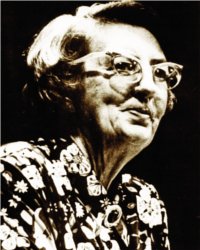Elizabeth Blackwell Award
Mary Douglas Leakey

Mary Douglas Leakey is credited with many anthropological discoveries including Homo habilis, a small tool-making creature some two million years of age; Homo erectus, a one-million-year- old probable successor to Homo habilis; and Kenyapithecus wickeri, a 14-million-year-old creature with human-like features.
While most children spent their days sitting in a classroom, Leakey spent her childhood traveling with her father, an artist, and visiting prehistoric sites in France. Her interest in history spurred Leaky to attend lectures on archaeology and, by the age of 17, she was clocking field hours working digs and illustrating the archeological process.
Her illustrations caught the attention of several archeologists and Leakey went on to illustrate several books. It was during one such project that Leakey met her future husband, Louis S. B. Leakey, an author and archeologist. The couple worked together, excavating side-by-side with their three sons.
In 1975, Leakey went to Laetoli, an East African site near the Olduvai Gorge, where she found a large variety of fossils, including jaws and teeth of at least 11 creatures believed to belong to the genus Homo. Fossils in this find were dated at 3.75 million years, adding a million years to the established record of evidence of human origins.
In addition to numerous honorary degrees, Leakey was the recipient of National Geographic magazine's Hubbard Medal and the Prestwych Medal of the Geological Society of London.
She died in 1996.
